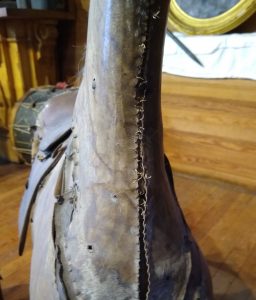 Child’s Rocking Horse – c. 1840 wood, animal hide, paint
Child’s Rocking Horse – c. 1840 wood, animal hide, paint
A popular children’s toy, rocking horses originated from the hobbyhorse, a long stick with a horse’s head used in medieval times. By the 16th century, the barrel horse was invented and the first known rocking horse appeared in England during the 17th century.

In the early 18th century, rocking horses were being made in America as well as Europe. Although most of these wooden horses were crudely made, wealthier families had handmade leather saddles, real horsehair tails and other elaborate accessories. By the late 18th – early 19th century, the rocking horse evolved into a work of art. Woodworkers were sculpting full-bodied rocking horses, making them more life-like than ever before.

With the onset of the Industrial Revolution and the end of the American Civil War, rocking horses became mass-produced, making them cheaper and more available to all children. The rocking horse business boomed into the early 20th century, until World War I and eventually the Great Depression. Due to the lack of spending money and building materials, the era of the rocking horse had peaked.
Now in the 21st, rocking horses are made in the many shapes and sizes from metal to wood. They have become popular again as collectors items, though most “antique” rocking horses are early 20th century horses.
This horse is an example of pre-industrial age workmanship. Lacking any discernible marks from the craftsman or company, it is difficult to date. We are able to surmise, however, that it came from a wealthier family due to the well made accoutrements, fuller hide-lined body and horse-hair mane and tail.
